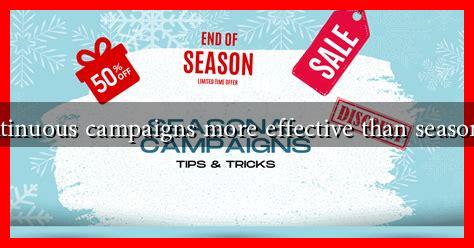-
Table of Contents
Are Continuous Campaigns More Effective Than Seasonal Ones?
In the ever-evolving landscape of marketing, businesses are constantly seeking the most effective strategies to engage their audience and drive sales. One of the pivotal decisions marketers face is whether to implement continuous campaigns or seasonal ones. This article delves into the effectiveness of these two approaches, examining their advantages, challenges, and real-world applications.
Understanding Continuous and Seasonal Campaigns
Before diving into the effectiveness of these campaigns, it’s essential to define what they entail:
- Continuous Campaigns: These are ongoing marketing efforts that run year-round, focusing on building brand awareness and customer loyalty over time.
- Seasonal Campaigns: These campaigns are time-bound and typically align with specific holidays, events, or seasons, aiming to capitalize on heightened consumer interest during those periods.
The Case for Continuous Campaigns
Continuous campaigns offer several advantages that can lead to long-term success:
- Consistent Brand Presence: By maintaining a steady marketing presence, brands can foster familiarity and trust among consumers. This consistency can lead to higher customer retention rates.
- Data-Driven Insights: Continuous campaigns allow marketers to gather data over time, enabling them to refine their strategies based on consumer behavior and preferences.
- Flexibility and Adaptability: With ongoing campaigns, brands can quickly pivot their messaging and tactics in response to market changes or emerging trends.
For instance, brands like Coca-Cola and Nike utilize continuous campaigns to maintain their market dominance. Coca-Cola’s “Share a Coke” campaign, which ran for several years, consistently engaged consumers by personalizing their products, leading to a significant increase in sales.
The Appeal of Seasonal Campaigns
On the other hand, seasonal campaigns can be incredibly effective when executed correctly:
- Heightened Urgency: Seasonal campaigns create a sense of urgency, encouraging consumers to act quickly to take advantage of limited-time offers.
- Targeted Messaging: These campaigns allow brands to tailor their messaging to specific events or holidays, making it more relevant to consumers’ current interests.
- Increased Engagement: Seasonal themes often resonate emotionally with consumers, leading to higher engagement rates on social media and other platforms.
A prime example of a successful seasonal campaign is Starbucks’ annual “Red Cup” promotion, which generates excitement and anticipation among customers each holiday season. This campaign not only boosts sales but also reinforces brand loyalty.
Comparative Effectiveness: Continuous vs. Seasonal
While both campaign types have their merits, research indicates that continuous campaigns may yield better long-term results. According to a study by the Harvard Business Review, brands that invest in continuous marketing see a 23% increase in customer loyalty compared to those that rely solely on seasonal promotions.
However, the effectiveness of each approach can vary based on industry, target audience, and specific business goals. For example:
- Retail Brands: Often benefit from seasonal campaigns due to the nature of consumer shopping habits during holidays.
- Service-Based Industries: May find continuous campaigns more effective as they focus on building long-term relationships with clients.
Conclusion: Finding the Right Balance
In conclusion, both continuous and seasonal campaigns have their unique advantages and challenges. Continuous campaigns excel in building brand loyalty and providing valuable consumer insights, while seasonal campaigns can create urgency and emotional engagement. The key for marketers is to find the right balance between the two approaches, leveraging the strengths of each to maximize their overall effectiveness.
Ultimately, the choice between continuous and seasonal campaigns should be guided by a brand’s specific goals, target audience, and market dynamics. By understanding the nuances of each strategy, businesses can craft marketing efforts that resonate with consumers and drive sustainable growth.

